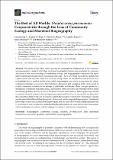The best of all worlds: Streptococcus pneumoniae conjunctivitis through the lens of community ecology and microbial biogeography
Author(s)
Ung, Lawson; Bispo, Paulo J. M.; Bryan, Noelle C.; Andre, Camille; Chodosh, James; Gilmore, Michael S.; ... Show more Show less
Downloadmicroorganisms-08-00046.pdf (1.197Mb)
Publisher with Creative Commons License
Publisher with Creative Commons License
Creative Commons Attribution
Terms of use
Metadata
Show full item recordAbstract
The study of the forces which govern the geographical distributions of life is known as biogeography, a subject which has fascinated zoologists, botanists and ecologists for centuries. Advances in our understanding of community ecology and biogeography--supported by rapid improvements in next generation sequencing technology--have now made it possible to identify and explain where and why life exists as it does, including within the microbial world. In this review, we highlight how a unified model of microbial biogeography, one which incorporates the classic ecological principles of selection, diversification, dispersion and ecological drift, can be used to explain community dynamics in the settings of both health and disease. These concepts operate on a multiplicity of temporal and spatial scales, and together form a powerful lens through which to study microbial population structures even at the finest anatomical resolutions. When applied specifically to curious strains of conjunctivitis-causing, nonencapsulated Streptococcus pneumoniae, we show how this conceptual framework can be used to explain the possible evolutionary and disease-causing mechanisms which allowed these lineages to colonize and invade a separate biogeography. An intimate knowledge of this radical bifurcation in phylogeny, still the only known niche subspecialization for S. pneumoniae to date, is critical to understanding the pathogenesis of ocular surface infections, nature of host-pathogen interactions, and developing strategies to curb disease transmission. Keywords: biogeography; community ecology; selection; diversification; drift; dispersion; Streptococcus pneumoniae; epidemic conjunctivitis; nonencapsulated
Date issued
2019-12-25Department
Massachusetts Institute of Technology. Department of Earth, Atmospheric, and Planetary SciencesJournal
Microorganisms
Publisher
Multidisciplinary Digital Publishing Institute
Citation
Ung, Lawson, et al., "The best of all worlds: Streptococcus pneumoniae conjunctivitis through the lens of community ecology and microbial biogeography." Microorganisms 8, 1 (Dec. 2019): no. 46 doi 10.3390/microorganisms8010046 ©2019 Author(s)
Version: Final published version
ISSN
2076-2607